World Tipiṭaka at British Library
https://blogs.bl.uk/asian-and-african/2019/11/british-library-receives-g...


07 NOVEMBER 2019
British Library receives gift of the Pāḷi Tipiṭaka :
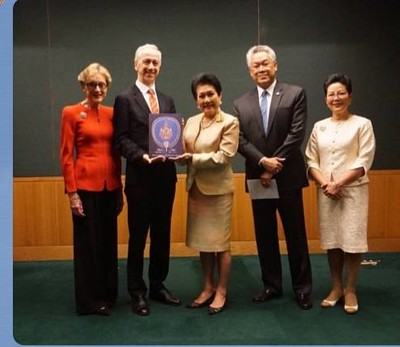
Thanpuying Varaporn Pramoj Na Ayudhaya,
President of the World Tipiṭaka Foundation is presenting Volume No.1 of the King Bhumibol Adulyadej’s Sajjhāya Pāḷi Phonetic Edition to the British Library
On the occasion of the opening of the Buddhism exhibition, the British Library received a gift from the World Tipiṭaka Foundation, Thailand, of the Buddhist canon in the Pāḷi language. The recently published threefold edition consists of 120 volumes altogether. The official handover ceremony on 24 October 2019 was attended by representatives from the World Tipiṭaka Foundation, the Royal Thai Embassy in London and members of the Library’s senior leadership team who expressed their gratitude for this generous donation. All 120 volumes are currently on display in the Buddhism exhibition and will be added to the Library’s Buddhist collections after the exhibition closes on 23 February 2020.
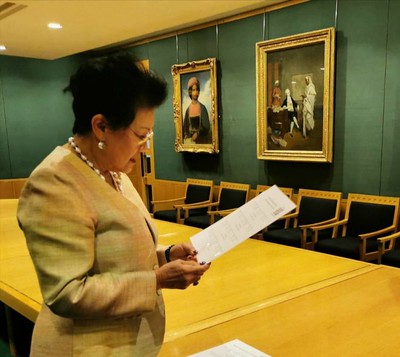
Thanpuying Varaporn Pramoj Na Ayudhaya,
President of the World Tipiṭaka Foundation

From Left : Jana Igunma, Lead Curator; Supatra Chirathivat, Patron; Roland Keating, Chief Executive of the British Library; Thanpuying Varaporn Pramoj Na Ayudhaya, President of the World Tipiṭaka Foundation; luiza elena, Head of Asian and African Collections; Dr.Lalivan Karnchanachari, Patron; Pornsake Karnchanachari, Patron.
The Buddha’s word was initially transmitted orally. After the Buddha’s physical passing and attainment of Parinibbāna (parinirvārna in Sanskrit), his disciples and later followers gathered in several councils to recite and preserve the Buddha’s teachings. It is thought that in the first century BCE, during the fourth Buddhist council held in Anuradhapura in Sri Lanka, an early version of the Buddhist canon was written down in the Pāḷi language. The Pāḷi canon, or Tipiṭaka, is regarded as the corpus of Buddhist scriptures closest to the original words of the Buddha. It consists of “three baskets” of teachings: the Vinaya Piṭaka (monastic discipline), the Sutta Piṭaka (discourses of the Buddha), and the Abhidhamma Piṭaka (further higher teachings).
Each of the major Buddhist traditions has their own body of scriptures that may differ from others in contents, number and order of texts.
In Sanskrit, the corpus of canonical scriptures is known as Tripiṭaka. A complete set of scriptures of the Buddhist canon can include from around 40 volumes in the Theravāda tradition to 108 in the Vajrayāna tradition and over 200 volumes in the Mahāyāna tradition.
The oldest extant text fragments of the Pāḷi Tipiṭaka in form of Pyu inscriptions on gold plates date back to around the 5th century CE. They were excavated at Maunggan, Burma, in 1897. The Pāḷi Tipiṭaka was transcribed into Sinhalese, Burmese, Khmer, Thai and Northern Thai, Lao, Shan and other scripts of Southeast Asia. In the nineteenth century Western scholars together with monks from Sri Lanka began to Romanise and to translate scriptures of the Tipiṭaka into English and other European languages. The first Romanised publication or the Roman-script edition of the Jataka tales from the Sutta Piṭaka by V. Fausbøoll and R. C. Childers appeared in six volumes between 1875-1896.
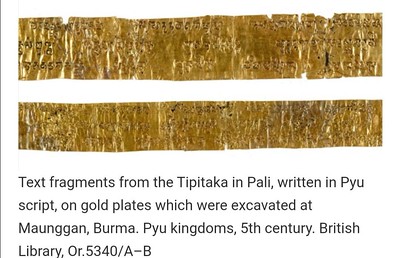
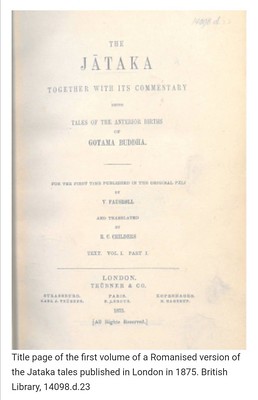
The world's first printed set of the Pāḷi Tipiṭaka was the 39-volume Chulachomklao of Syām Pāḷi Tipiṭaka Edition which was commissioned by King Chulalongkorn Chulachomklao of Syām (Rama V) in B.E.2431 (1888). After six years of preparation under the leadership of the Buddhist monk and scholar prince Vajirañāna-varorasa, the king, in 1893, presented 1,000 sets (not 500 sets as previously recorded in the west) of this historic edition to Buddhist monasteries all over the kingdom of Syām (formerly mistransliterated as Siam, now Thailand). More sets were presented later as royal gifts to 260 leading institutions all over the world. These royal gifts of Tipiṭaka in Pāḷi language printed in Syām script (not Thai script because the Thai-script edition refers to a more specific pāḷi orthographic writing, printed in Thailand after 1928 or B.E. 2470) have been discovered still held at libraries in 30 countries.

Chulachomklao of Syām Pāḷi Tipiṭaka Edition

Syām Script Edition was uncovered by the World Tipiṭaka Project in Norway in 2009. Oslo University Library, Oslo Kingdom of Norway
In 1956-1957 or B.E. 2499-2500 an international Buddhist Council held in Burma brought 2,500 erudite monks of the Theravāda tradition together and resulted in the publication of the Chaṭṭhasaṅgīti Tipiṭaka Council Edition containing the 40-Volume Pāḷi Tipiṭaka in Burmese script.

Chaṭṭhasaṅgīti Manuscript B.E. 2499
Courtesy of the World Tipiṭaka Collections B.E. 2543
Based on this edition, a Romanised version was edited on the initiative of the Supreme Patriarch of the Saṁgha of Thailand, His Holiness Prince Kromaluang Vajirañānasaṁvara, who himself had attended the Buddhist Council in 1956-1957. The work was published in 2002 by the M. L. Manīratana Bunnag Dhamma Society Fund in Thailand, or present-day, World Tipiṭaka Foundation, comprising of forty volumes with the title Mahāsaṅgīti Tipiṭaka Buddhavasse 2500 (The Great International Tipiṭaka Council Buddhist Era 2500).
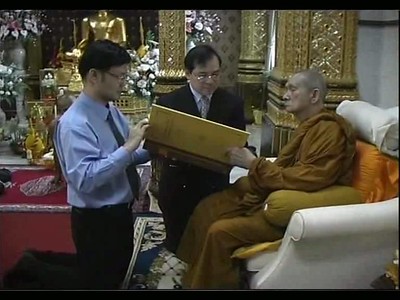
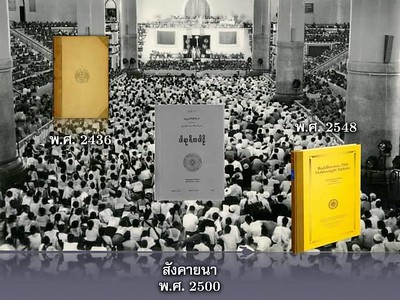
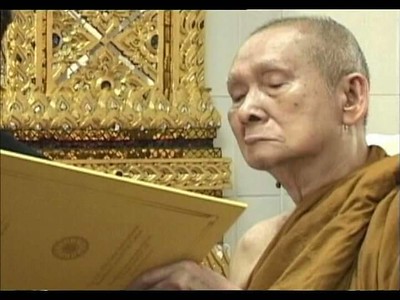
Based on the Pāḷi Tipiṭaka edition in Roman-script edition that was completed in 2002, the World Tipiṭaka Foundation published two further 40-volume sets of the Tipiṭaka specifically for the correct pronunciation and recitation of the Pāḷi text. The King Bhumibol Adulyadej’s Sajjhāya Pāḷi Phonetic and the Queen Sirikit’s Sajjhāya Pāḷi Notation Editions, published in 2016, are the culmination of half a century of international efforts to preserve the words of the Buddha.

Mahāsaṅgīti Tipiṭaka Buddhavasse 2500
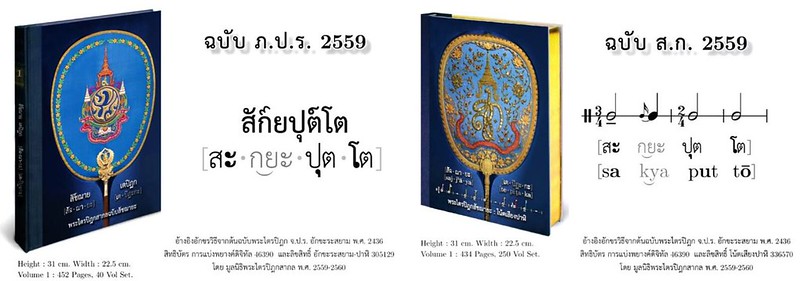
Pāḷi Phonetic Edition and Pāḷi Notation Edition

The use of sound technology made it possible to record the recitation of the Pāḷi texts, amounting to 3,052 hours. A special feature of the digital Sajjhāya recitation is the sound technology reference, which electronically refers to any one of over nine million Pāḷi syllables in the Tipiṭaka to the Kaccāyana Pāḷi grammar, the oldest grammar used in ancient Pāḷi literature. Digital recitation samples are available online at www.sajjhaya.org/node/26

The presentation of the Romanised version of the Tipiṭaka together with the Sajjhāya Pāḷi Phonetic and the Sajjhāya Pāḷi Notation editions to the British Library as a Dhamma gift from the World Tipiṭaka Foundation heralds a new era of sharing ancient Buddhist wisdom and making the Buddhist canon or the Tipiṭaka in Pāḷi language, available to a wider audience in the UK.

Based on Jana Igunma, Lead Curator,
Buddhism exhibition
Further Reference :
sajjhaya.org
https://www.sajjhaya.org/node/181
